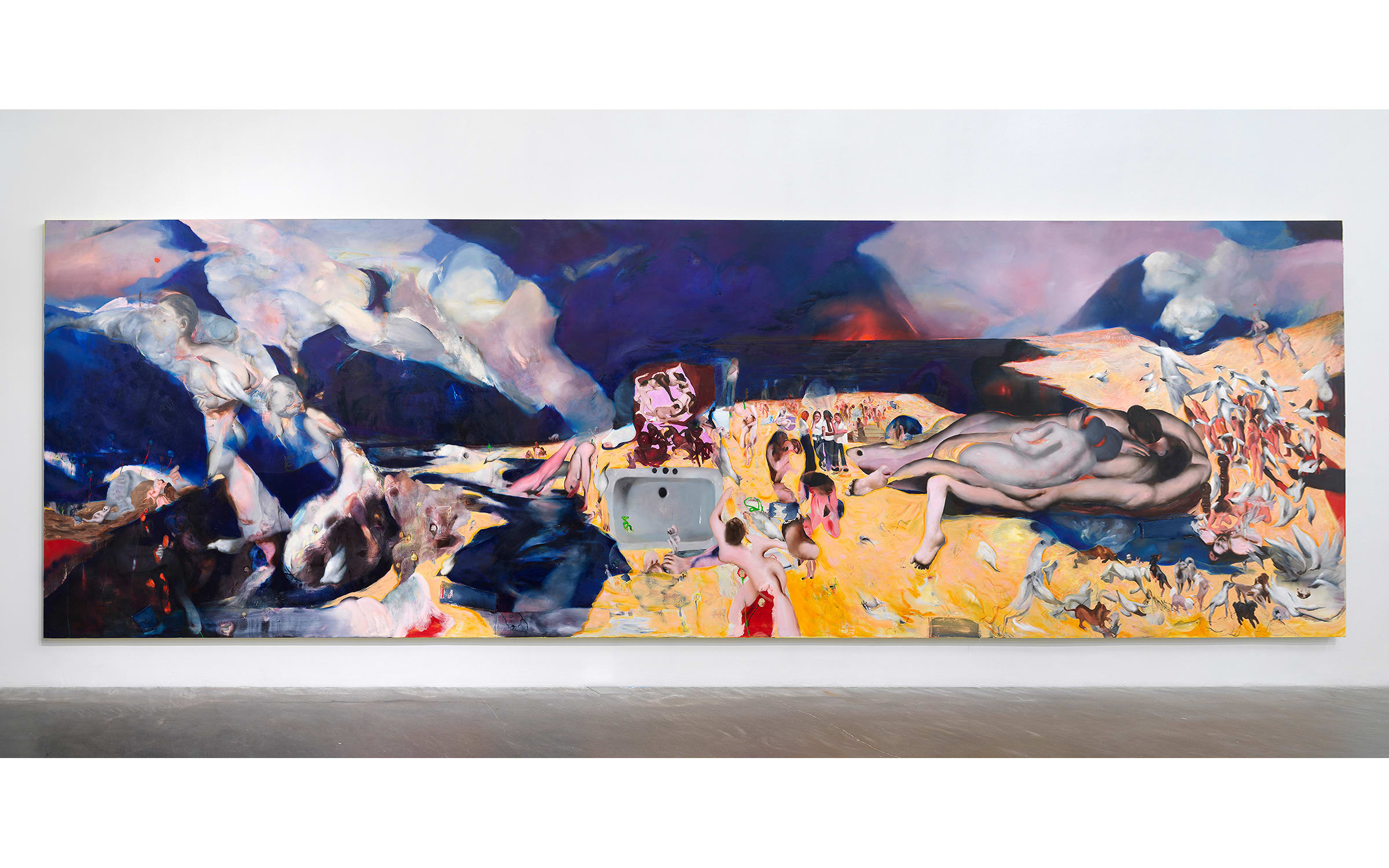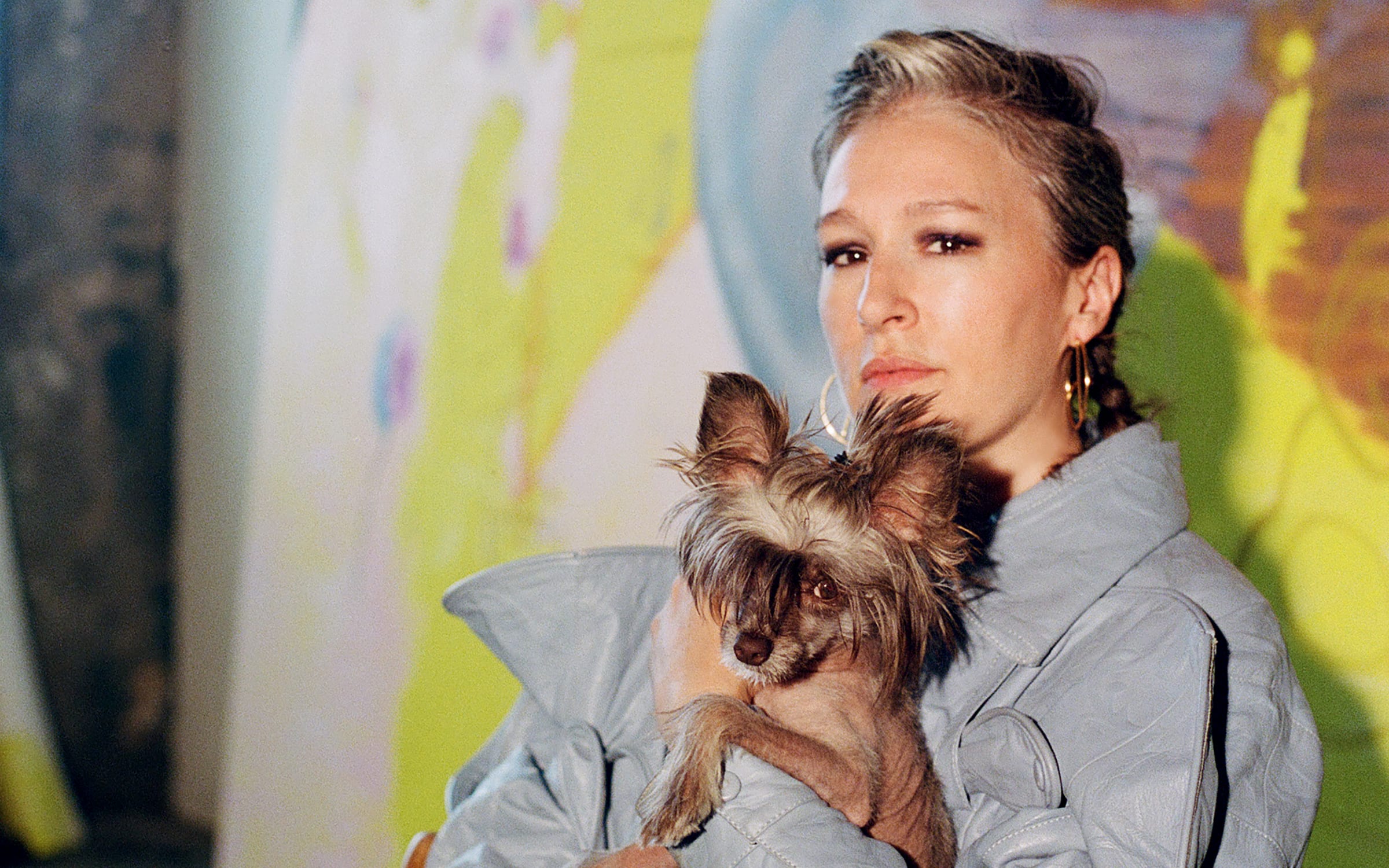Ambera Wellmann’s largest work to date, and one of the few paintings displayed in the New Museum’s 2021 triennial ‘Soft Water Hard Stone’, Strobe (2021) shows a depraved stretch of sand where all manner of filth has washed ashore.
On this radioactive beach, which sweeps horizontally for an overwhelming 9 meters, nearly hairless dogs chase down a flock of white seagulls. A sex scene floats above, as curved characters modeled after Ingres’s Grande Odalisque (1814) lie across the peninsula, their nude physiques incomplete and interlocking, turned away and framed at one end by a pair of bedposts with knobs on. Elsewhere, the hazy outline of one figure’s facial features morphs into vaporous clouds, while a shiny sink looks poised to slurp the whole Boschian arrangement down its drain. Strobe is Wellmann painting at a boiling point: Everything lacks a definite shape.

More than any of Wellmann’s previous works, Strobe is a grand record of its own failures. There is no logical narrative, no clear focal point, no attempt to draw clean conclusions. Uncertainty is a mist over Wellmann’s obscure depictions of spectrous humans, apocalyptic landscapes, and bathroom fixtures. She sometimes bookends her picture planes with floating figures that mirror each other, an attempt to generate an endless visual loop by redirecting the gaze toward the orgiastic vignettes within. Her bodies are distortions in time, ambiguous and fragmented, with liquid skin and lopped-off limbs, so that they appear in perpetual action.
‘I am oftentimes just looking for an arrangement with the bodies that actually feels impossible, in order to create a diagram for what kind of infinite possibilities the body can have,’ she says. ‘That’s the place where I’m trying to get the painting to not necessarily end at, but stop at.’ Ever kind to her audience, Wellmann also incorporates recognizable elements, like torn strips of denim, to ground the viewer in intimate moments. Dried pansies are pressed onto the lower half of Strobe, dotting the sky or sprouting from the golden block of land into red, blue, and yellow petals. The blossoms seem to make eye contact.
Painted florals have frequently bloomed within Wellmann’s recent works: Gooey, brilliant red poppies swirl around and crash into pale fingers, green pears, and miniature horses in the eerie painting Seance Etiquette (2020), which she showed in New York during her recent solo exhibition ‘Nosegay Tornado’ at Company Gallery.
The pansies reflect a memory from Wellmann’s childhood that still resonates with warmth. In the past few years, the 39-year-old artist has moved between dense metropolitan areas including Berlin and Mexico City, and now lives alone with her dog, a Chinese crested she named Chicken, in the Lower East Side of Manhattan. But Wellmann was raised in a ‘dreary log cabin in the middle of the woods’ with no indoor plumbing in remote Nova Scotia, Canada. Winters were unrelenting, but come spring her mother’s garden would explode with color. ‘My mom grew these beautiful pansies that we would pick and press in books,’ she recalls. ‘I was thinking about the folk art that I grew up with and used some of the techniques and childlike hobbies we would do when we were kids to beautify our environment.’

Wellmann’s parents were not especially creative, she says, and her primary school’s art programs were cut when she was young. What stuck with her were the handmade decorations of her small hometown of Bridgewater – the whirligig lawn sculptures, for example, of birds whose wings spun in the wind – as well as the few images that hung in her home. For years she was fascinated by two postcards her mother brought back from the Museo del Prado in Madrid. One bore a picture of Goya’s grim Saturn Devouring His Son (1819–23), while the second featured a painting by Picasso that depicted a mother tenderly breastfeeding her child. ‘I felt this powerful pull toward both of those things, terror in one of them and profound care in the other,’ she says. ‘I feel those things still in my work.’
It can be difficult to detangle these sensations from pure desire when viewing Wellmann’s art. The central character in Foot Fetus (2019) is either receiving head or giving birth. Her legs, rendered through soft strokes and with few restraining outlines, dissolve into another. In another intimate vista, Nox Tendencies (2020), watery figures are seemingly both scissoring and multiplying.
Wellmann knew that she would someday leave Bridgewater to pursue a fine art education, but it was for a record-store-manager position that she moved to the nearby port city of Halifax. She started studying at Nova Scotia College of Art and Design in 2007 in her mid-twenties, and there she found a community. ‘I never really felt like I had one until I entered the art school system,’ she says. ‘I was meeting other kids who were misfits like me for the first time.’ While attending graduate school at the University of Guelph in Ontario, she began painting porcelain objects, with their inevitably gendered associations, as uncanny stand-ins for corporeal forms. After becoming a finalist in the RBC Canadian Painting Competition in 2016, she was awarded the coveted top prize the following year for a painting titled Temper Ripened (2017), which depicts a ceramic swan decorated with crude cobalt-blue line drawings capturing scenes of sexual violence.
Her work simultaneously found a different audience online. Social media users flocked to her Instagram, where in addition to pictures of her paintings she frequently posted absurd and sometimes discomforting snapshots – a toilet wearing a toupee, pen drawings of eyes on her fingers – that she intended to be ‘deliberately stupid,’ she says. ‘It was a nice release, a way to make something that was instantly gratifying and instantly forgettable.’ She deleted the account when the follower count reached 85,000, but in some ways she still organizes her practice like an Instagram feed. One wall of her Bushwick studio is usually covered with papers printed with images she references throughout her process, a mix of art-historical works and photos culled from the internet.
For Strobe, that was the sink. But her latest body of work, which Wellmann will unveil at Art Basel in Miami Beach, centers on the bedroom. It’s a site of naked vulnerability – of lovemaking, as is frequently the case between Wellmann’s queer subjects, but also of sickness and death. It is an equalizing space: Bodies, when lying down, are without hierarchy. And so she will transform the exhibition into a fantasy boudoir with an antique wooden bed surrounded by dreamlike paintings cast in shadow. ‘I’m thinking about the bed as a frame and as a framework for the paintings,’ she says. She has painted the headboard and footboard with near-mirror images depicting circles of nude people in various flesh tones plunging into tear-shaped ponds. Surrounding the water are fields filled with flecks of green denoting grass and heaps of flowers – dried white and yellow pansies – that are pressed onto the wood. The blooms, as ever, seem to look back.
Coco Romack is a writer, editor, and author based in New York.
Ambera Wellmann is represented by Company Gallery, New York City, and Kraupa-Tuskany Zeidler (K-T Z), Berlin.
Discover more related content below:
Captions for full-bleed images, from top to bottom: 1. Ambera Wellmann, Blue Bouquet (detail), 2020. 2. Ambera Wellmann, The Unicorn Captivity (detail), 2020. 3. Ambera Wellmann, Séance Etiquette (detail), 2020. 4. Ambera Wellmann, Psychogenic Fugue (detail), 2020. 5. Ambera Wellmann, Strobe (detail), 2021. All images courtesy of the artist and Company Gallery, New York City.


